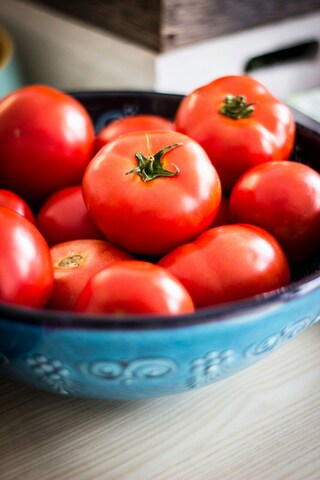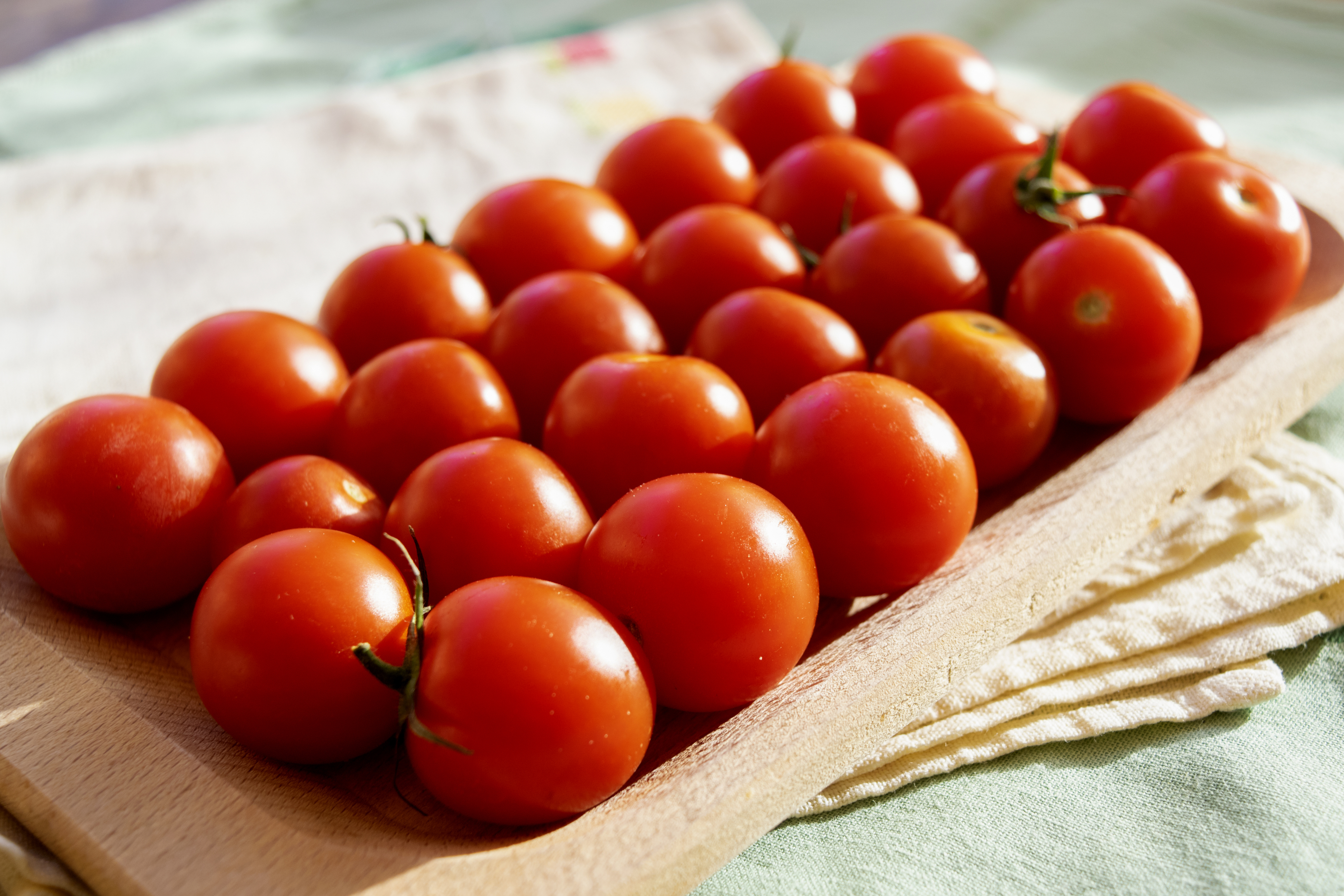
Photo by Deniz Altindas
Tomatoes have become almost synonymous with Italy, but they had a long, incredible journey before they reached European plates.
It's a topic that fascinated writer Clarissa Hyman, whose book Tomatoes: A Global History charts the origins of this vibrant and juicy fruit while covering topics such as tomato varieties, breeding and genetics, nutrition, and tomatoes in art. It also includes tomato recipes.
Clarissa, who previously published Cucina Siciliana, a "cook's tour" of Italy's largest island, got her start as a TV producer, working on factual programs, documentaries, educational programs, and adult education.
She isn't Sicilian (or Italian, for that matter), but she's earned a reputation and awards for her skills in marrying food writing with lessons in history. At the heart of all of her works is a sense of curiosity and wonder: Just how did these foods make their way to global cuisine?
I recently had the chance to chat with Clarissa about tomatoes. We discussed the tomato's origins, the ways it spread, how the perception of the tomato has changed, and the fruit's influence on food and culture.
Tell us how the tomato found its way to Europe.
I became fascinated by the Columbus Exchange, of which tomatoes were a part. I was also fascinated by what happened even earlier: how tomato seeds traveled from mostly Peru and the northern part of South America up towards Mexico. How did they get there?
Once they got to Mexico, they found a home, a climate that really encouraged their growth and proliferation. Clearly, the Aztecs didn't seem concerned about whether or not they were going to be poisonous or inedible in some way, and they took to them very readily.
Franciscan Friar Bernardino de Sahagún wrote in a journal about all the different tomatoes he came across in Mexico. He went with the conquistadors as a missionary and wrote about hundreds of different sorts of tomatoes in different colors, sizes, shapes, and attributes.
When I read what he wrote, I thought, "This is so sophisticated, this understanding of the tomato's potential and how diverse and varied it could be."
This is not something we think about in terms of the 16th century. We're very arrogant in our day and age about how advanced we are. But in fact, there's very little that's not been done before. So that very much engaged me.
How the tomato actually got to Europe, to Spain, again, is another story in itself. How did the sailors and the ships actually transport these tomatoes? I mean, they were out to sea for such a long time, and tomatoes weren't going to last. So, did they dry them? Did they preserve them? Did they just take the seeds?
I suppose anything that came from the Americas to Spain and Portugal was going to be precious in some way. It was going to be valuable; even if they didn't know just what that value was, you couldn't just throw it overboard.
History is never simple. It never works on one track, or often, tracks run in parallel.
Some explorers gave the royal families of Spain just about everything that they found. It was part of their job to bring everything over. Some people in the aristocracy were very interested in botanical things, cultivation, and horticulture, and they had beautiful gardens and skillful gardeners who were ready to experiment with plant things and see what happened.
Once tomatoes started to grow, there were others who wouldn't eat them or weren't interested. But there were also some very poor people who were grateful to eat anything, even if it was going to be a little bit dodgy. They were prepared to give it a go if it was cheap and easy and grew well.
So, there were different roots for tomatoes becoming increasingly available in the marketplace in Spain. That's where it all started in terms of European consumption of tomatoes.
One of the main drivers of tomatoes being incorporated into European gastronomy and culinary culture was the monasteries and the friars and the priests, who had an amazing culinary dimension to their lives. A number of priests and monks wrote cookery books or recorded what they did in the kitchens of the monasteries. Because a lot of monks traveled around visiting different outposts of their particular order, they took this knowledge with them.
One of the main ways that tomatoes started to spread around the Mediterranean basin was through trade, but there were certainly other roots in religion. The Jewish communities took this vegetable knowledge with them, even when other people were still reluctant.
Tell us about that reluctance.
It was very pervasive and lasted a long time. A lot of people thought, "Well, we know it's part of the nightshade family, so maybe it could be poisonous."
Early tomatoes were probably rather acidic and didn't really have the sweetness that was bred into them eventually. So they didn't like it. People didn't know what to do with it. I think a fear of poisoning really prevented its rapid adoption.
But bit by bit, people became a bit more adventurous. It's so interesting how gardeners have been able to improve plants and turn them into something a bit more palatable, as well as cross-breed and encourage certain characteristics.
There are always a few brave souls somewhere who are going to try something new and radical and say, "Hey, look, I'm still standing. I ate a tomato."
How did tomatoes return to the Americas?
The technological advance of canning again gave a huge impetus to how tomatoes could then spread back to the Americas in the form of tin tomatoes. And it was, again, the whole story of Italian tomatoes and Italian-American communities, which is a big story on its own because the canning came from a time when a lot of Italians emigrated to America at the end of the 19th century. There were a lot of Italian producers and merchants in Italy who saw that they could supply the Italian immigrants, particularly on the East Coast, with some of the foods that they remembered from their homelands, and tomatoes came full circle.
However, there was also another route for tomatoes to become so popular in North America: people planted tomatoes or took tomato plants from Central America and Mexico up to California and Louisiana, often through the missions in California or through the French influence in Louisiana.
Tomatoes were found to flourish in those more northern regions. And so that was another route, helped by the development of the railways, which could transport fresh tomatoes.
How have tomatoes influenced global cuisine?
You certainly can't think of pasta without tomato sauce or a pizza without tomato sauce in some way.
The influence of tomatoes on global cuisine is incalculable. Where would we be without tomatoes? I can't think of a cuisine or a culture that doesn't use tomatoes in some important way now, which is extraordinary when you think the world ate perfectly well before the Columbus Exchange took place. And certainly in Europe, North America, and Asia, I mean, there was a very good diet. There's a very good culinary culture in virtually every country in the world without a tomato. So it's really quite extraordinary, the power that the tomato has had to transform virtually all our lives. And I think it's because it's something that can be consumed in so many different forms, and it's worked its way into lots of different aspects of our life for good or bad.
You can think of some hideous tomato things: tomato-flavored crisps and even tomato ice cream. But overall, tomatoes have been a force for good when it comes to the food on our plates.
I don't mean to say every dish we eat has a tomato in it or is tomato-connected. Of course not. But it's such an integral part of our lives now. It's very hard to imagine it not being there. Certainly, when it comes to Italian food, it's a marriage that has lasted for a very long time in terms of pasta and pizza.
What are some varieties unique to Sicily?
There is a variety called Siccagno that grows in western Sicily that isn't watered. Any moisture comes from rain. They are the most amazing-tasting tomatoes. Then, there is a place in eastern Sicily where a very tiny tomato called Pachino is grown virtually on the beach in very sandy soil. They say they get their flavor from the sea, somehow from the aromas of the saltwater. The winds and the waves somehow infuse these tomatoes, and they're brilliant.
The Sicilians really appreciate different varieties and sizes and understand their uses. Some tomatoes are just for use in a sugo, and some tomatoes can be eaten in a salad with a little bit of oil.
Pachino tomatoes photo by Salmassara
You've mentioned that one shouldn't refrigerate tomatoes.
I met an Italian tomato grower, and he said to me, "You English are terrible. I really can't believe it. You murder your tomatoes."
I said, "What do you mean by murder? How do you murder a tomato?"
He said, "You always put them in the fridge. That's the worst thing you can do with a tomato."
He said the cold destroys all the flavor and aroma. He said he'd never forget going to an English home. He went into the kitchen, opened the refrigerator door, and saw half a tomato wrapped in cling film. And he said his heart nearly stopped.
He said that in Italy, you buy a tomato and eat it. You don't leave it in the fridge for a week until you're ready to eat the rest of it.
So I tell everyone that if they've got tomatoes in the fridge, take them out.
What do you hope people take away from your research?
It's such a fascinating story and one that is so largely unknown. It's actually a little miracle, a little red round miracle, and we should respect it a lot more than we do.
>>Get Tomatoes: A Global History here!<<
If you enjoyed this article, consider subscribing to my newsletter for more content and updates!

